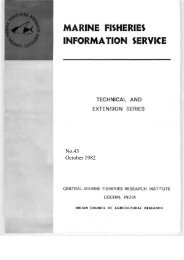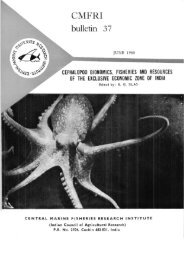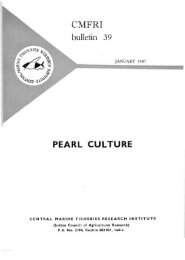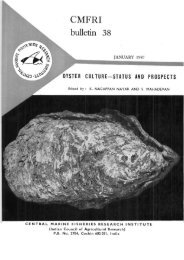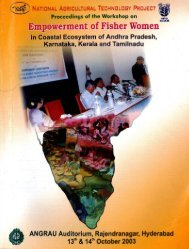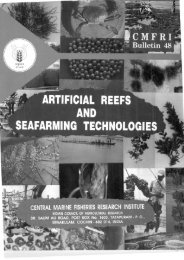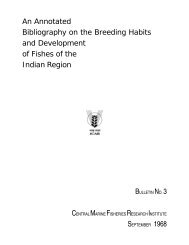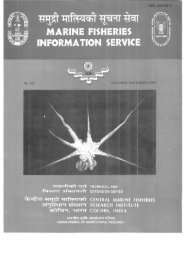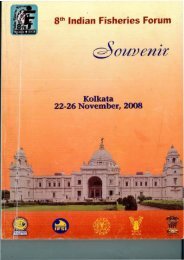Marine Fisheries Information Service - Eprints@CMFRI - Central ...
Marine Fisheries Information Service - Eprints@CMFRI - Central ...
Marine Fisheries Information Service - Eprints@CMFRI - Central ...
Create successful ePaper yourself
Turn your PDF publications into a flip-book with our unique Google optimized e-Paper software.
<strong>Marine</strong> <strong>Fisheries</strong> of Andhra Pradesh-An Appraisal 7<br />
and the carangids. Prawns and crabs too are caught<br />
by this gear at times. The catch trend here also<br />
showed an increasing trend over the years. Details<br />
of the shore seines and the boat seines are given in<br />
Table 3.<br />
The shoreseines are operated all along the coast<br />
seasonally. The operation is labour oriented and<br />
fishing is carried out on a community basis in the<br />
coastal villages. Shoreseines are operated within<br />
20 m from the shoreline and 25-40 people are<br />
involved in the operation of pedavala and 80-100<br />
persons in the operation of alivivala. The gear mainly<br />
targets the near-shore shoaling fishes like mackerel,<br />
seerfish, carangids, silverbellies and anchovies.<br />
Juveniles are also landed by this gear during March-<br />
April (Plate 3). As the gear is operated very close to<br />
the shore, most of the fish caught are live when<br />
brought out of water. The Visakhapatnam Regional<br />
Centre of CMFRI undertook a rapid survey of the<br />
shoreseine operation and its catch along a<br />
110 km coastal stretch from Visakhapatnam to<br />
Kalingapatnam and estimated the number of juveniles<br />
in the catch.<br />
(peddavala) - 1100 kg (alivivala) of fish per haul.<br />
Generally two or three hauls are made per day by the<br />
peddavala and one haul by the alivivala.<br />
Remuneration to the fishermen depends on the<br />
quantity of commercially important (seerfish,<br />
mackerel and carangids) fishes caught. However the<br />
presence of exceptionally large quantities of juveniles,<br />
especially of commercially important fishes, in the<br />
catch during certain months is alarming. Enquiries<br />
during the present rapid survey revealed that this is a<br />
common phenomenon along this coast every year.<br />
Young fishes were abundant during March-April<br />
contributing to nearly 3.5 % of the total catch by<br />
weight. Interestingly, the juvenile catch consisted only<br />
of seerfish (40%) and mackerel (60%). The total<br />
length of seerfish ranged from 60 to 120 mm and<br />
that of mackerel from 50 to 100 mm (Fig.13) and<br />
weighed 2 to 17 g and 2 to 10 g respectively. The<br />
average length and weight of seerfish was estimated<br />
at 90 mm and 6 g respectively.<br />
Length in mm<br />
Plate 3. Juveniles seerfish landed by shoreseines at<br />
visakhapatnam<br />
Shoreseining was active along this stretch with<br />
an estimated 50 units operarting along this stretch.<br />
Though the gear can be operated throughout the year<br />
whenever conducive weather conditions prevail, the<br />
availability of fish shoals in the nearshore area<br />
determines the season of operation. It is generally<br />
operated from October to April with the peak season<br />
being November to March. Operation is mainly carried<br />
out from early morning hours (06.00 h) to late<br />
afternoon (15.00 h). Each unit gets around 200 kg<br />
Fig. 13. Length Frequency distribution of seerfish<br />
juvenile caught by shoreseine at Visakhapatnam<br />
The quantity (in numbers) of young ones of<br />
mackerel and seerfish in the shoreseine catch was<br />
estimated. On an average, 1200 numbers of juveniles<br />
were landed by a shoreseine unit per haul. These<br />
trends wherein juveniles are landed in large quantities<br />
are observed for about 25 days from mid March to<br />
the second week of April. Over a period of 25 fishing<br />
days and an average of two hauls per unit, an<br />
estimated 30,00,000 number of juveniles are landed<br />
by 50 units along the stretch of coastline surveyed.<br />
The number of seerfish in the catch was estimated<br />
at 12,00,000 and mackerel comprised the remaining




